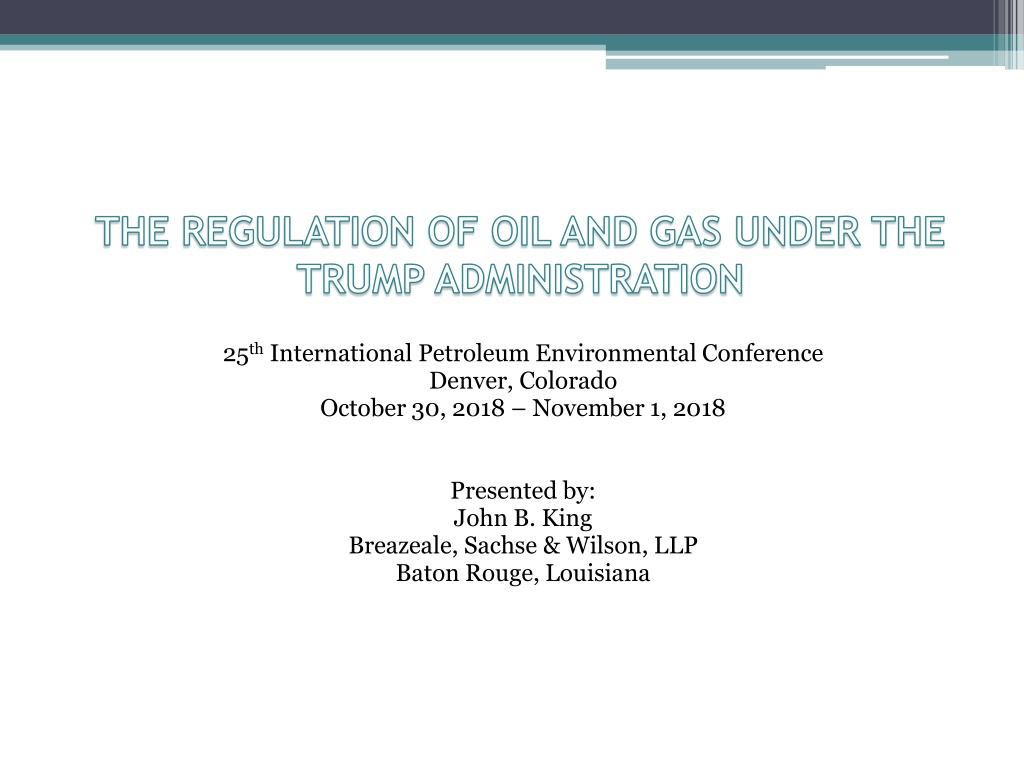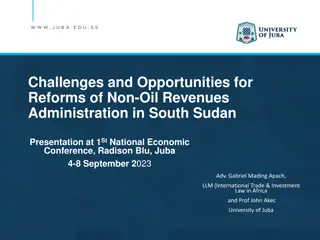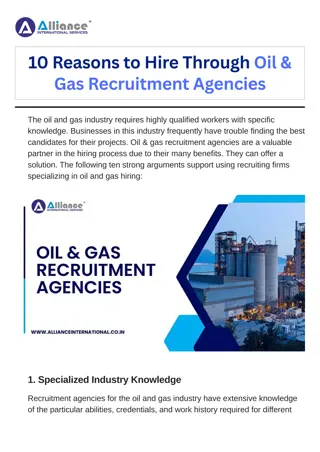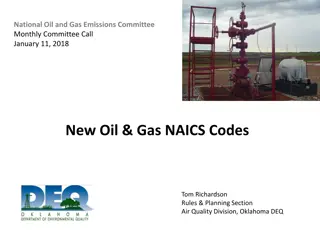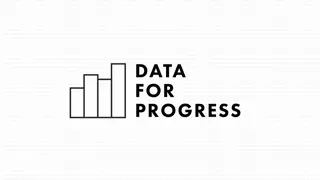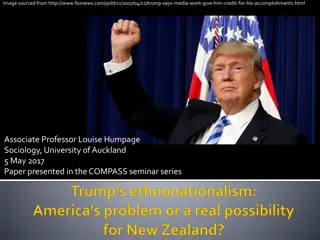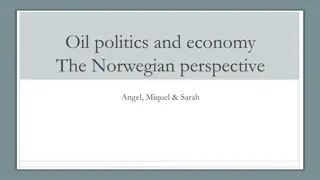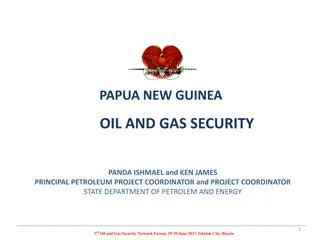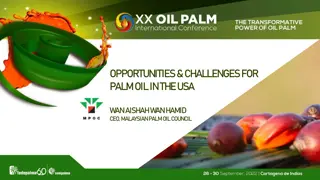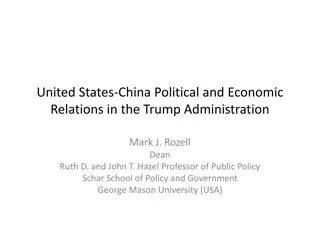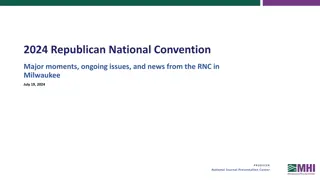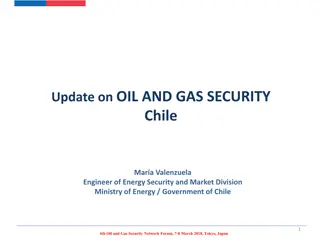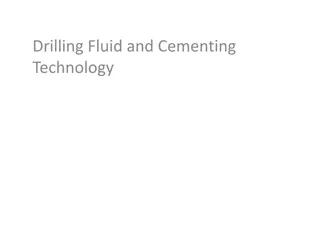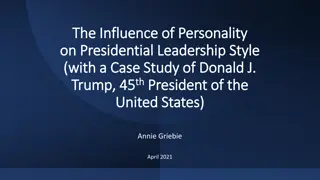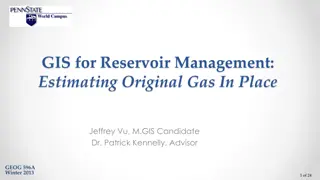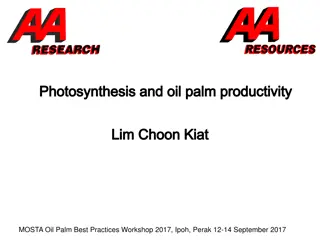Regulation of Oil and Gas Under the Trump Administration
The presentation discusses the regulation of oil and gas under the Trump administration, covering presidential actions, offshore initiatives, and the impact on energy independence and economic growth. It highlights executive orders, policy changes, and implications for offshore drilling and leasing programs.
Uploaded on Sep 25, 2024 | 0 Views
Download Presentation

Please find below an Image/Link to download the presentation.
The content on the website is provided AS IS for your information and personal use only. It may not be sold, licensed, or shared on other websites without obtaining consent from the author.If you encounter any issues during the download, it is possible that the publisher has removed the file from their server.
You are allowed to download the files provided on this website for personal or commercial use, subject to the condition that they are used lawfully. All files are the property of their respective owners.
The content on the website is provided AS IS for your information and personal use only. It may not be sold, licensed, or shared on other websites without obtaining consent from the author.
E N D
Presentation Transcript
THE REGULATION OF OIL AND GAS UNDER THE TRUMP ADMINISTRATION 25thInternational Petroleum Environmental Conference Denver, Colorado October 30, 2018 November 1, 2018 Presented by: John B. King Breazeale, Sachse & Wilson, LLP Baton Rouge, Louisiana
THE REGULATION OF OIL AND GAS UNDER THE TRUMP ADMINISTRATION Oil and Gas Presidential Actions Offshore and Onshore Methane NSPS Pipelines Other Rules Impacting Oil and Gas Clean Water Rule Climate Compliance and Enforcement Questions
Oil and Gas Presidential Actions Promoting Energy Independence and Economic Growth -Executive Order No. 13783, March 28, 2017 -Ordered review all existing regulations that potentially burden the development or use of domestic energy Final reports due 180 days after order -Rescinded multiple climate-related policies and guidance, such as President s Climate Action Plan Climate Action Plan Strategy to Reduce Methane Emissions -Ordered review of Clean Power Plan Social Cost of Carbon Multiple EPA and Interior rules on oil and gas Implementing an America-First Offshore Energy Strategy -Executive Order No. 13795, April 28, 2017 -Policy to encourage energy exploration and production, including on the Outer Continental Shelf -Interior ordered to give full consideration to revising the schedule of proposed oil and gas lease sales so that it includes previously off-limit areas -Ordered review of two final rules and one proposed rule that applied to off-shore operations
Oil and Gas Offshore Department of Interior Order 3350, May 1, 2017 Implements EO 13795, April 28, 2017 Ordered development of new 5-Year OSC leasing program (for 2019-2024) -To include Alaska, Mid-Atlantic, South Atlantic, and Gulf of Mexico -Noted that 2017 2022 Program (Jan. 2017) excluded Atlantic and parts of Alaska -Forgoes tens of billions barrels of oil and 100 trillion cubic feet of gas Addressed several rules that applied to off-shore operations -Offshore Air Quality Rule Proposed at 81 Fed. Reg. 19717 (April 5, 2016) Ordered that all activities to finalize rule be stopped -Well Control Rule Final rule at 81 Fed. Reg. 25888 (April 29, 2016) Ordered review to suspend, revise, or rescind Revision proposed at 83 Fed. Reg. 22128 (May 11, 2018) Final rule sent to OMB? -Offshore Artic Drilling Rule Final rule at 81 Fed. Reg. 46478, (July 15, 2016) Ordered review to suspend, revise, or rescind Changes considered but not yet proposed
Oil and Gas Offshore Draft National OSC Program 2019-2024, January 4, 2018 -Implements EO 13795 and Order 3350 -Will replace the 2017 2022 Program -Covers 90% of OSC -47 potential lease sales in 25 of 26 planning areas -Comment period ended on March 9, 2018
Oil and Gas Onshore Department of Interior Order 3354, July 6, 2017 -Steady decline in leases on federal lands between 2009 2016 -BLM had 2,802 pending applications to drill as of Jan. 31, 2017, with 257 days average to process -Order 3354 to ensure quarterly lease sales are held and ensure faster permitting Tax Cuts and Jobs Act, Dec. 22, 2017 -Opened up ANWR 1002 Area for drilling -1.5m acres of 19M acres in ANWR -Lease to occur within 4 years and a second lease within seven years
Oil and Gas Onshore Hydraulic Fracturing Rule, 80 Fed. Reg. 16128 (March 26, 2015) -Applicable on Federal/Indian lands -Stayed and on appeal in Tenth Circuit -Rescinded by BLM, 82 Fed. Reg. 61924 (December 29, 2017) Waste Prevention Rule, 81 Fed. Reg. 83008 (November 18, 2016) -Applicable on Federal/Indian lands -Limits amount of flaring, adds leak detection, reduces venting -Interior ordered to review the rule by EO 13783 (March 28, 2017) -BLM attempted to suspend or stay the rule for one year, 82 Fed. Reg. 58050 (Dec. 8, 2017) US District Court (ND CA) enjoined implementation of Suspension Rule on Feb. 22, 2018 -Certain portions of rule stayed by district court in Wyoming on April 4, 2018 California, New Mexico, and NGOs seeking review of stay in Tenth Circuit -Interior proposed to rescind and/or revise, 83 Fed. Reg. 7924 (Feb. 22, 2018) -Final rule issued on September 18, 2018, 83 Fed. Reg. XXXX (XXX, 2018) Rescinds requirements on LDAR, waste minimization plans, gas capture percentages Revising to reflect BLM s venting and flaring policies that pre-date 2016 rule
Oil and Gas Methane NSPS The 2012 NSPS Rule -77 FR. 49490 (Aug. 16, 2012) -40 CFR 60, Subpart OOOO -New facilities as of Aug. 23, 2011 -Targets VOCs -RECs or green completions -Storage tanks -Equipment leaks The 2016 NSPS Rule -81 FR 35824 (June 3, 2016) -40 CFR 60, Subpart OOOOa -New facilities as of Sep. 18, 2015 -Targets methane and VOCs -Subpart OOOO applies between Aug. 23, 2011 and Sept. 18, 2015 -Owners/operators to find and repair leaks -Next Generation Enforcement, such as optical gas imaging -General duty added at 40 CFR 60.5370a(b) and to Subpart 0000
Oil and Gas Methane NSPS Attempts to stay, delay, and revise -EPA announces it will review rule pursuant to EO 13783, 82 Fed. Reg. 16331 (April 4, 2017) -EPA convenes proceeding to reconsider the rule, Pruitt Letter dated April 18, 2017 Mentions the fugitive emission monitoring requirements -EPA issues Notice of Reconsideration and Partial Stay, 82 Fed. Reg. 25730 (June 5, 2017) Stay issued for three months Fugitive emission requirements, well site pneumatic pump standards, and certification by PE Vacated on July 3, 2017 (Clean Air Council v. EPA) -EPA issues proposes stay of two years, 82 Fed. Reg. 27645 (June 16, 2017) Fugitive emission requirements, well site pneumatic pump standards, and certification by PE -EPA Notice of Data Availability 82 Fed. Reg. 51788 (Nov. 8, 2017), 82 Fed. Reg. 51794 (Nov. 8, 2017) -EPA issues final rule on some of the proposals, 83 Fed. Reg. 10628 (March 12, 2018) relates to figutive emissions Amends requirement that leaking components be repaired during unplanned/emergency shutdowns NOTE: Still required to repair during next shutdown or two years, whichever is earlier Amends monitoring survey requirements for well sites on the Alaskan North Slope Otherwise, Methane NSPS is in effect, including -Initial monitoring survey of fugitive emissions was required by June 2, 2017 -Reporting Initial Semi-annual Report and Semi-Annual Report under 60.5422a(b) Annual Report under 60.5420a(b) 90 days after initial compliance period (one year from start-up or August 2, 2016)
Oil and Gas Methane NSPS EPA issues proposal to substantially amend rule on September 11, 2018 -83 Fed. Reg. 52056 (October 15, 2018) Three types of amendments -Amendments for provisions on which reconsideration was granted Fugitive emission requirements Well site pneumatic pumps standards PE certification of closed vent systems AMEL (alternative means of emission limitations) -Amendments to clarify and streamline implementation Well completions (location of a separator during flowback, screenouts and coil tubing cleanouts) Onshore natural gas processing plants (definition of capital expenditure and monitoring) Storage vessels (maximum average daily throughput) General clarifications (certifying official and recordkeeping and reporting) -Technical amendments
Oil and Gas Methane NSPS Source: EPA Memo, April 12, 2018
Oil and Gas Methane NSPS Well site pneumatic pumps standards -Technical infeasibility of control installation or use was categorically unavailable at greenfield (or new) sites If new, operator could incorporate proper controls into design -Proposed to expand technical infeasibility provision to all sites and eliminate categorical distinction between sites PE certification of closed vent system (CVS)/ pneumatic pump technical infeasibility -Proposed to allow certification by PE or in-house engineer with expertise on design/operation of CVS/pump AMEL (alternative means of emission limitations) -AMEL available by submitting data demonstrating alternative will achieve at least equivalent emission reductions -Proposed to incorporate emerging technologies and existing state programs Well completions (location of a separator during flowback, screenouts and coil tubing cleanouts) -Separator may be located at or near the well site so that it is able to commence separation flowback Near may include a centralized facility or well pad that services the well -Screenouts and coil tubing cleanouts are not part of the flowback period
Oil and Gas Methane NSPS Source: EPA Proposed Rule
Oil and Gas - Pipelines Both subject of Presidential Memoranda, January 24, 2017 Keystone XL Federal permits issued Suits filed over EIS Dakota Access Easement granted by Corps on Feb. 8, 2017 Drilling completed and in service Corps ordered to review its permit decision Corps reaffirmed its decision on August 31, 2018
Other Rules - Clean Water Rule Clean Water Rule, 80 Fed. Reg. 37054 (June 29, 2015) Legal proceedings -Numerous suits filed in numerous district courts and appellate courts -Nationwide stay issued in State of Ohio, et al v. U.S. Corps of Engineers, et al, 803 F3d 804 (6thCir. 2015) -National Assoc. of Manufacturers v. DOD, US Supreme Court, Jan. 22, 2018 - appellate courts have no jurisdiction Administrative proceedings -Executive Order #13778 , dated February 28, 2017 - ordered review of Clean Water Rule Seek to define navigable waters as per Justice Scalia s opinion in Rapanos -EPA Intention to Review and Rescind or Revise the Clean Water Rule, 82 Fed. Reg. 12532 (March 6, 2017) Announced two-step process Step 1: Re-establish status quo in place prior to 2015 Rule Step 2: Propose new rule to replace 2015 Rule -Step 1 Reinstated prior rule, 82 Fed. Reg. 34899 (July 27, 2017) Applicability date of 2015 Rule is Feb. 6, 2010, 83 Fed. Reg. 5200 (February 6, 2018) The Applicability Rule was challenged and overturned in 22 states -Step 2 Public meetings, received written recommendations, but no proposed rule at this time EPA announced on October 3 that proposed rule to be issued in 30 days
Other Rules - Climate -Removed WH climate page within minutes of inauguration The Trump Administration -Revokes/rescinds most Obama-area climate policies Executive Order 13783, March 28, 2017 -President Trump announced withdrawal on June 1, 2017 -Based decision on: Economic hardship on United States Payments to Green Fund Lack of reductions by China and India Paris Agreement -Proposal to repeal, 82 Fed. Reg. 48035 (October 16, 2017) -Proposed Affordable Clean Energy (ACE) Rule to replace CPP 83 Fed. Reg. 44746 (August 31, 2018) Clean Power Plan -83 Fed. Reg. 16077 (April 13, 2018) -Model Year 2022 2025 Light-Duty Vehicles -Standards based on outdated information or too stringent -Will consider appropriate standards for these model years -California and other states suing Mid-Term Evaluation of GHG Emissions
Other Rules - Climate Source: EPA
Compliance and Enforcement Oil and Gas Prior audit policies -General Audit and Self-Disclosure Policy, April 2000 EPA still had to collect economic benefit portion of penalty -General New Owner Audit Policy, August, 2008 EPA could waive all of economic benefit portion of penalty in certain circumstances New Owner Clean Air Act Audit Program -EPA seeking feedback on the program -Applies to upstream oil and gas exploration and production sector -Well sites, including associated storage tanks and pollution control equipment -EPA observed significant emissions and noncompliance at these facilities Issued Compliance Alert in September, 2015 Emissions from tank batteries due to undersized and poorly maintained vapor control systems Implemented by a Draft Agreement -New owner Cannot be responsible for environmental compliance prior to the date of acquisition New owner and seller cannot have the largest ownership share of each other New owner and seller cannot have a common corporate parent New owner must notify EPA with six month of the date of acquisition -Scope of audit Must assess engineering and design of vapor control system for all facilities included in the audit Includes detailed instructions and guidelines for reviewing these systems Can be broader than the vapor control systems -Must correct in a timely manner -Must provide semi-annual report(s) and a final report -If all done, EPA agrees to resolve civil penalty liability by not imposing a civil penalty Includes the gravity and economic incentive portions of the civil penalty
Compliance and Enforcement Oil and Gas National Enforcement Initiatives (2017 2019) begun in October, 2016 Ensuring Energy Extraction Activities Comply with Environmental Laws -Need to assure that energy sources are developed in an environmentally protective manner -Some techniques for NG extraction pose a significant risk to public health and environment -Continue to address pollution through greater use of Advanced pollution monitoring Reporting techniques Next Generation technologies (infrared cameras to make the invisible visible )
Compliance and Enforcement Oil and Gas Transition from NEIs to National Compliance Initiatives -EPA Memorandum, August 21, 2018 from Susan Bodine -Will rename NEIs to NCIs in FY 2019 -Sends message that increased compliance is the goal and that enforcement is not the only tool -Discusses NCIs for FY 2020-2023 Discusses how current NEIs will be addressed in next cycle -Currently seeking input from stakeholders Ensuring Energy Extraction Activities Comply with Environmental Laws -For FY 2019, work to focus on significant health and environmental problems Exposure to significant releases of VOCs Reducing non-attainment Reducing water quality impairment -For FY 2020-2023, EPA will consider Merge into the Cutting Hazardous Air Pollutants NCI, or Focus this NCI on -Significant sources of VOCs that have substantial impact on air quality (without regard to sector) , and -Returning other work in this sector to core program and regional priorities
Questions? John B. King Breazeale, Sachse & Wilson, LLP 225/381-8014 jbk@bswllp.com www.bswenviroblog.com
